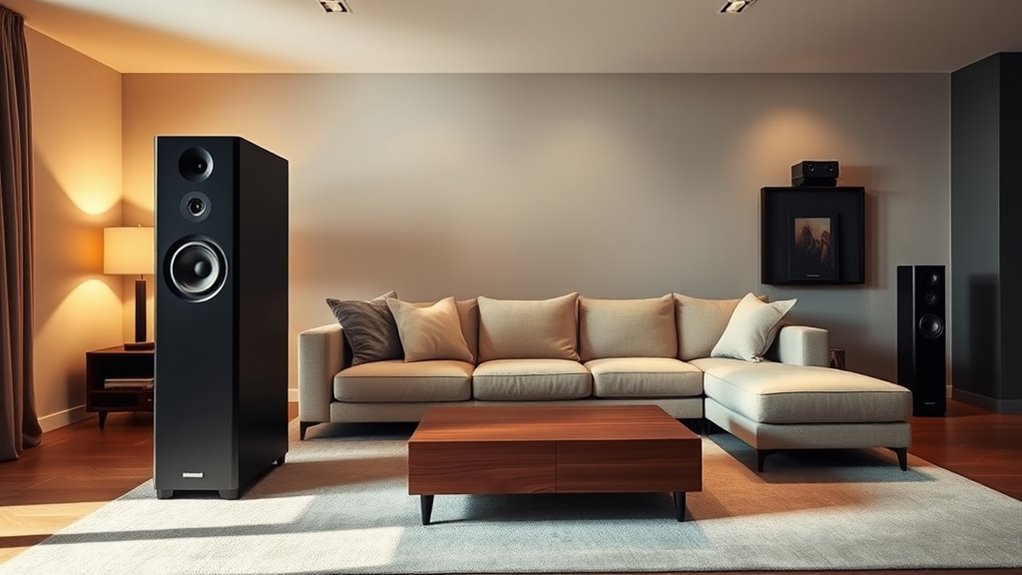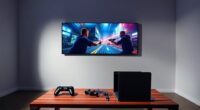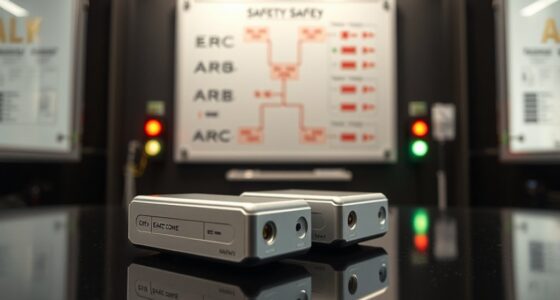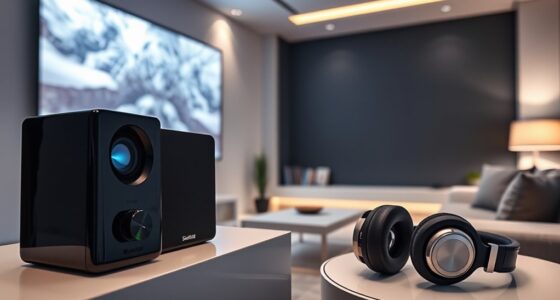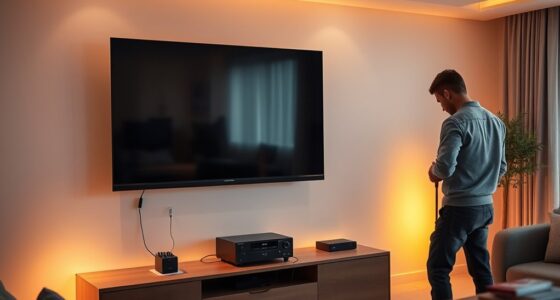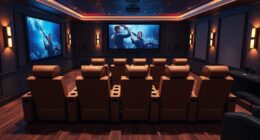To optimize your sound, start by placing your speakers at ear level and forming an equilateral triangle with your listening spot. Make certain they’re spaced about 6 to 10 feet apart, aimed directly at you for clear stereo imaging. Minimize reflections by controlling room acoustics—use panels, rugs, or curtains—and avoid hiding subwoofers in corners. Small adjustments in placement can notably improve sound clarity and depth; explore these tips further to truly transform your audio experience.
Key Takeaways
- Position speakers at ear level and angle them toward the listening spot for optimal clarity and stereo imaging.
- Maintain 6 to 10-foot spacing between speakers, forming an equilateral triangle with the listening position.
- Use acoustic treatments like panels and diffusers to reduce reflections and improve sound clarity.
- Experiment with subwoofer placement to achieve balanced bass and minimize standing waves.
- Avoid placing speakers directly against walls or in corners to prevent bass boom and acoustic distortions.
Understanding the Ideal Listening Environment

Creating the ideal listening environment begins with understanding how your space affects sound. The placement of your speakers influences how sound waves travel, bounce, and reflect within the room. To optimize sound quality, consider the speaker height; positioning them at ear level minimizes distortions caused by room reflections. When speakers are too high or low, sound waves bounce off walls and ceilings unevenly, creating echoes and muddiness. Room reflections can considerably impact clarity, so avoid placing speakers where they will bounce off hard surfaces directly. Instead, aim for a setup that minimizes these reflections, allowing sound to reach your ears directly and clearly. Recognizing how room characteristics interact with speaker placement helps you achieve a balanced, immersive listening experience. Proper speaker placement also involves understanding the types of headphone jacks, which can influence your overall audio setup and connectivity options.
The Importance of Speaker Height and Ear Level
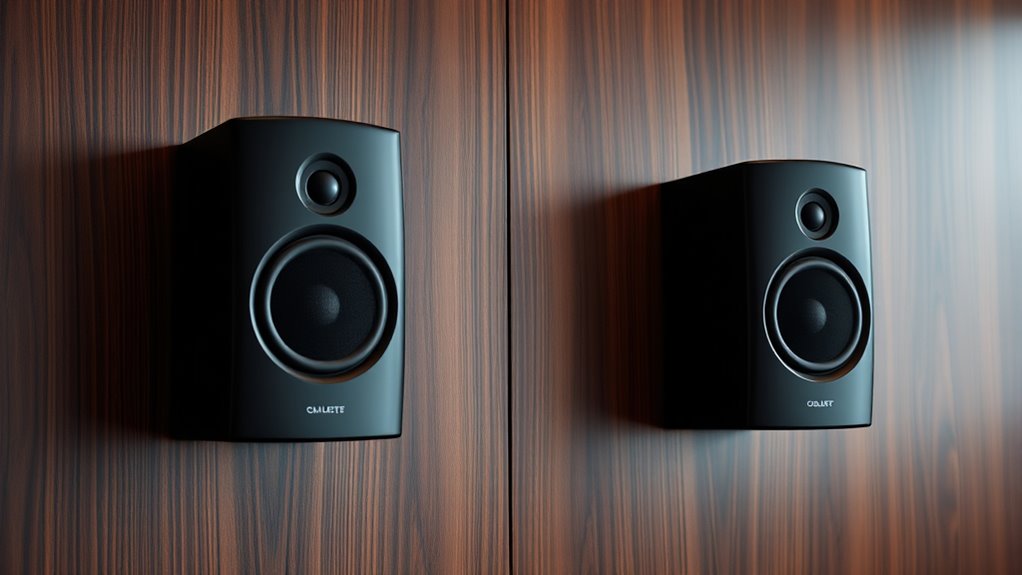
Positioning your speakers at ear level is crucial because it guarantees that sound travels directly to your ears without unnecessary reflections or distortions. When speakers are aligned with your listening position, you achieve better clarity and accurate sound staging. Proper speaker orientation enhances this effect, ensuring sound is directed toward your ears, not the walls or ceiling. This setup is especially important for subwoofer integration, as placing the subwoofer at ear level helps blend deep bass seamlessly with the main speakers. Keep in mind that higher or lower placement can cause sound to reflect or become muffled, reducing overall quality. Adjusting speaker height to ear level creates a more immersive experience, delivering balanced sound and making your listening sessions more enjoyable. Additionally, speaker placement can significantly impact the overall acoustics of your space, emphasizing the importance of precise positioning.
Optimal Distance and Spacing Between Speakers
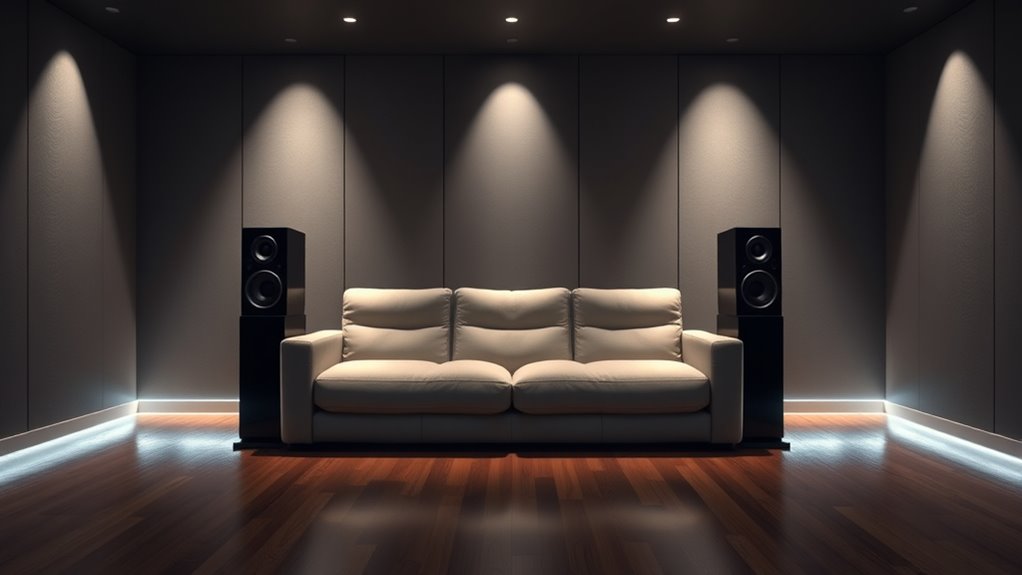
Ensuring the right distance and spacing between your speakers is key to achieving balanced and immersive sound. Proper speaker angle helps direct sound toward your listening position, creating a seamless stereo image. For ideal subwoofer placement, position it near your main speakers but avoid blocking vents or placing it too close to walls, which can cause muddiness. Usually, spacing speakers about 6 to 10 feet apart works well, but this depends on your room size. Remember, too close can cause bass pooling, while too far apart may create gaps in sound coverage. Experiment by adjusting speaker angles slightly inward, aiming to form an equilateral triangle with your listening spot. This setup ensures even sound distribution and an engaging listening experience. Additionally, considering robotics advancements can help in automating speaker calibration for optimal sound quality.
The Role of Room Acoustics and Treatments
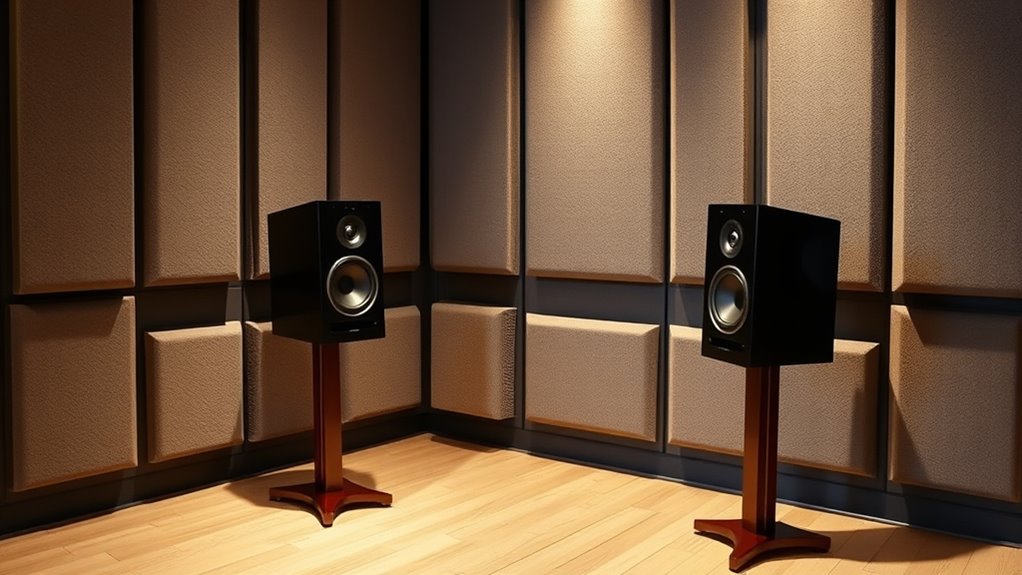
Room acoustics play a fundamental role in how your sound system performs, as they directly influence sound clarity, balance, and immersion. Poor acoustics can cause echoes, muddiness, or uneven sound distribution. To improve this, consider implementing sound absorption techniques and acoustic panels. These treatments help reduce reflections and control reverberation, creating a clearer listening environment. Imagine:
- Soft acoustic panels on walls, soaking up excess sound
- Bass traps in corners to manage low-frequency buildup
- Rugs and curtains that dampen sound bouncing off hard surfaces
- Diffusers that scatter sound waves evenly throughout the room
- Utilizing textile line solutions like fabric-covered panels to enhance both aesthetics and sound absorption
The Impact of Placement on Soundstage and Imaging
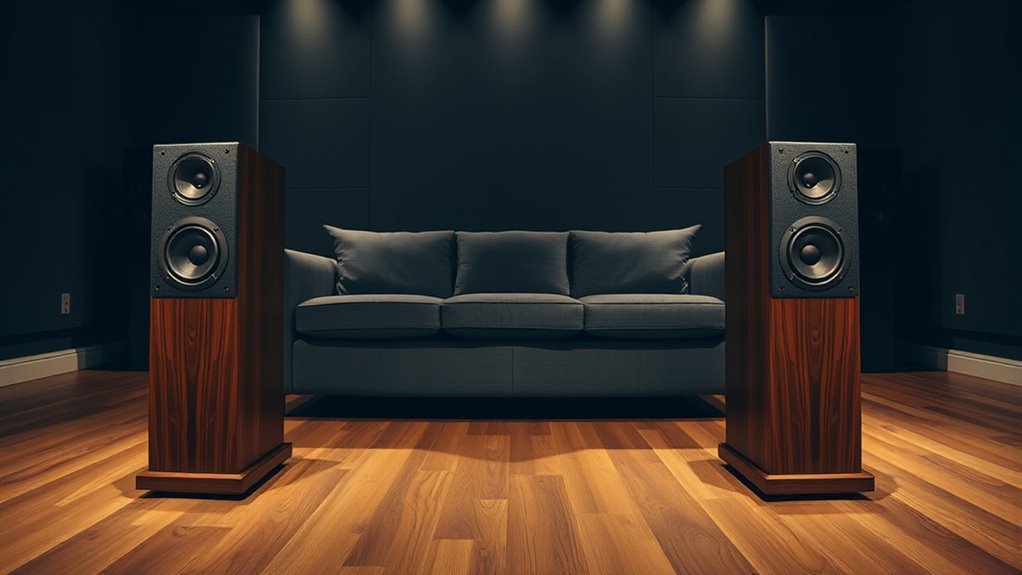
Your speaker placement directly affects the clarity of your stereo image and how precisely you can pinpoint sounds. Spacing your speakers correctly can create a wider, more realistic soundstage, while poor placement introduces confusing reflections. Understanding how room reflections influence imaging helps you optimize placement for the best listening experience. Incorporating expert voice techniques can further enhance the realism and immersion of your soundstage.
Stereo Image Precision
Proper speaker placement plays a crucial role in creating a precise stereo image, allowing you to accurately perceive the location of instruments and vocals within the soundstage. When your speakers are correctly positioned, the stereo imaging becomes sharper, giving you a clear sense of space and depth. This enhances your listening experience by making it feel more natural and immersive. To improve stereo image precision, focus on how placement affects bass response and soundstage width. Properly placed speakers prevent sound from blending or smearing, ensuring each instrument occupies its own space. Additionally, understanding the contrast ratio of your audio setup can help in optimizing clarity and depth, especially in dynamic scenes.
Speaker Spacing Effects
Speaker spacing directly influences the width and clarity of your soundstage, shaping how you perceive the placement of instruments and vocals. Proper spacing enhances voice localization, making it easier to pinpoint individual sounds within a mix. When speakers are too close together, the soundstage can feel narrow, reducing the sense of depth and imaging accuracy. Conversely, placing them too far apart can cause phase issues and imbalance. Ensuring speaker symmetry is essential; symmetrical placement helps maintain consistent sound pressure and imaging across the stereo field. This balance improves overall clarity and helps you experience a more natural, immersive listening environment. Adjusting speaker spacing with these principles in mind allows you to fine-tune your setup for ideal soundstage and precise imaging. Additionally, considering the Water Parks in your area can serve as a fun analogy for understanding optimal placement—just as the right layout in a water park ensures smooth flow and enjoyment, proper speaker positioning guarantees a seamless listening experience.
Room Reflections Influence
Have you ever noticed how sound reflections from walls and furniture can distort the clarity of your music? These wall reflections and furniture interference can blur your soundstage and weaken imaging. When sound bounces off surfaces too close or poorly positioned, it creates overlapping echoes that muddy the main audio. This can make instruments seem less precise or vocals less focused. To visualize this, consider:
- Sound waves bouncing unpredictably off nearby walls
- Furniture creating uneven reflections that disrupt sound clarity
- Reflections causing stereo images to smear or shift
- Improper placement amplifying interference and reducing soundstage depth
- Incorporating room reflection control techniques can significantly improve your listening experience.
Common Mistakes to Avoid When Positioning Speakers

One of the most common mistakes when positioning speakers is placing them too close to walls or corners, which can cause undesirable sound reflections and bass booms. Proper speaker orientation is essential; pointing speakers directly at your listening position ensures clearer sound. Avoid angling speakers inward or outward excessively, as this can distort the stereo image. When it comes to subwoofer placement, don’t hide it behind furniture or in corners without testing; this often results in exaggerated bass. Instead, experiment with different locations to find the spot that offers balanced low frequencies. Remember, the goal is to minimize reflections and standing waves, so avoid placing speakers or subwoofers in spots that create sound distortions—this will improve overall clarity and listening experience. Additionally, understanding the tuning aspects of your audio setup can significantly enhance sound quality.
Frequently Asked Questions
How Do I Choose the Best Speaker Type for My Space?
To choose the best speaker type for your space, consider your room size, shape, and acoustics. Opt for speakers with adjustable orientation to direct sound effectively and guarantee even coverage. Proper speaker calibration is key—use tools or professional help to fine-tune your setup, minimizing echoes and dead spots. This approach guarantees clear, balanced sound, making your space perfect for listening or entertaining.
Can Furniture Placement Affect My Speaker Setup?
Yes, furniture placement can substantially affect your speaker setup. Your decorating styles and furniture arrangement influence sound reflection and absorption, impacting audio quality. Strategically positioning furniture and incorporating acoustic treatments like rugs or curtains can minimize unwanted echoes and improve clarity. Experiment with different layouts to find the best balance between style and acoustics, ensuring your space enhances your listening experience without sacrificing your home’s aesthetic.
What Tools or Equipment Help Optimize Speaker Placement?
You can optimize speaker placement with tools like acoustic panels and speaker stands. Acoustic panels help improve sound quality by reducing reflections and echoes, making your setup clearer. Speaker stands bring your speakers to the ideal height, ensuring balanced sound distribution. Use a tape measure or a laser level for precise positioning. These tools help you achieve the best sound experience, whether you’re listening casually or aiming for professional-quality audio.
How Often Should I Reassess My Speaker Arrangement?
You should reassess your speaker arrangement whenever you notice changes in sound quality or after significant room modifications. Regularly check your speaker calibration to guarantee ideal sound, and consider sound absorption adjustments to reduce reflections. Reassessing every 3 to 6 months helps maintain the best sound experience, especially if you move furniture or add acoustic treatments. Stay attentive to acoustics, and fine-tune your setup for consistent, high-quality audio.
Does Room Size Influence the Number of Speakers Needed?
Think of your room as a canvas; its size definitely influences how many speakers you’ll need. Larger spaces require more speakers to fill the silence, while smaller rooms may need fewer to prevent overwhelming sound. Acoustic treatments and soundproofing techniques help optimize sound quality, ensuring clarity and balance. So, yes, room size directly impacts your speaker setup, and adjusting for it can transform your listening experience from good to extraordinary.
Conclusion
Remember, your room is like a canvas, and speaker placement is your brushstroke—every detail shaping the masterpiece of sound. When you position your speakers thoughtfully, you open a world where music and movies come alive, filling your space with emotion and clarity. Don’t settle for mediocrity; craft your perfect listening environment. With patience and care, you’ll turn your space into a sanctuary where sound truly sings—just as the pros have always known.
